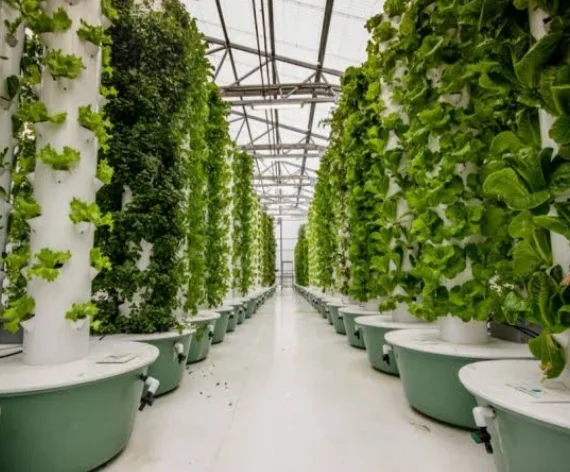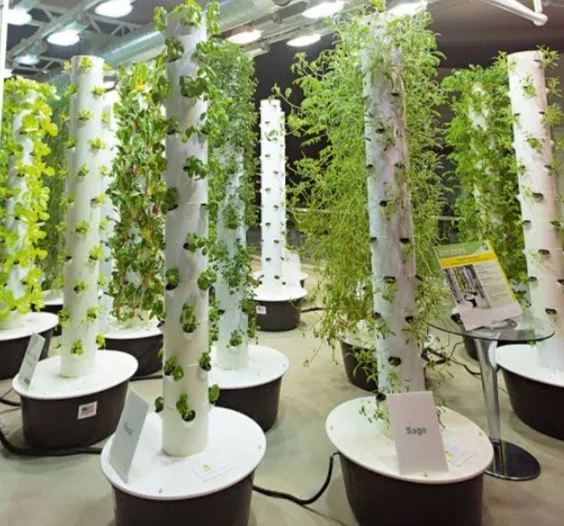Introduction Vertical Farming Technology
What is Vertical Farming
Vertical farming is a technique for growing crops in stacked layers, often indoors and in a controlled environment. This means that plants can be grown year-round, regardless of the climate outside.
Vertical farms typically use soilless farming techniques, such as hydroponics, aquaponics, and aeroponics.
How does it work?
Vertical farms use a variety of technologies to create the optimal conditions for plant growth.
These technologies include:
- Artificial lighting: Plants need light to grow, and vertical farms use LED lights to provide the right amount of light for each crop.
- Climate control: The temperature, humidity, and CO2 levels in a vertical farm are carefully controlled to optimize plant growth.
- Nutrient delivery: Plants in vertical farms are grown in nutrient-rich water or mist, rather than soil. This allows them to absorb nutrients more efficiently.
- Sensors and automation: Vertical farms use sensors to monitor the growing conditions and automation systems to adjust them as needed.
Benefits of vertical farming
There are many potential benefits to vertical farming, including:
Here's a rundown on the numerous benefits of vertical farming:
Increased Yields:
Vertical farming maximizes space by stacking grow layers, enabling significantly higher yields compared to traditional farms. This means producing more food on a smaller footprint, especially crucial as the global population continues to rise.
Reduced Water Usage:
- Reduced water usage: Vertical farms can use up to 95% less water than traditional farms.
Vertical farms often utilize hydroponics, aeroponics, or aquaponics systems, which are much more water-efficient than traditional soil-based farming. These systems can use up to 95% less water, a major benefit in areas facing water scarcity.
Reduced Pesticide Use:
- Reduced pesticide use: The controlled environment of a vertical farm makes it less susceptible to pests and diseases, so fewer pesticides are needed.
Controlled environments in vertical farms minimize exposure to pests and diseases, leading to a significant reduction in pesticide use. This contributes to safer food and a healthier environment.
Reduced Transportation Costs and Emissions:
- Reduced transportation costs: Vertical farms can be located in cities, close to consumers, which can reduce transportation costs and emissions.
Vertical farms can be located in urban areas, closer to consumers. This cuts down on transportation needs, minimizing food miles and associated greenhouse gas emissions. Fresher produce also reaches consumers faster.
Year-Round Production:
- Year-round production: Vertical farms can produce crops year-round, regardless of the weather conditions outside.
Vertical farms are not at the mercy of weather conditions. Controlled environments enable year-round food production, regardless of external factors like seasonality or extreme weather events. This enhances food security and stability.
Improved Food Quality and Safety:
Precise control over temperature, humidity, and nutrient delivery in vertical farms leads to consistently high-quality produce. Additionally, the closed environment minimizes contamination risks, resulting in safer food.
Reduced Land Use:
Vertical farming requires minimal land compared to traditional agriculture. This frees up valuable land for other purposes like conservation or housing, especially important in densely populated areas.
Improved Labor Conditions:
Vertical farming often involves automation and controlled environments, leading to safer and more comfortable working conditions for farm workers.
Potential for Local Food Production:
Vertical farms can be established in urban areas, promoting local food production and consumption. This fosters community food resilience and reduces reliance on long-distance food supply chains.
While vertical farming presents exciting possibilities, it's still an evolving technology with challenges like high initial costs and energy consumption. However, continued advancements and cost reductions hold immense promise for revolutionizing food production and ensuring sustainable food security for the future.
Challenges of vertical farming Technology
There are also some challenges to vertical farming, including:
Vertical farming, while brimming with potential, faces several challenges that hinder its widespread adoption.
Here are some of the key hurdles:
1. High Initial Cost: Setting up a vertical farm involves significant capital expenditure. From constructing specialized facilities to investing in sophisticated equipment like LED lighting and climate control systems, the initial investment can be daunting for newcomers. This high barrier to entry limits the growth of the industry.
2. Energy Consumption: Operating a vertical farm demands a lot of energy to maintain optimal conditions for plant growth. LED lighting, climate control systems, and ventilation contribute significantly to the energy footprint. Finding sustainable and cost-effective energy sources remains a crucial challenge.
3. Limited Crop Variety: Not all crops are suitable for vertical farming. Crops with high space requirements like corn or wheat are impractical. Additionally, some crops require pollination by insects, which can be challenging to manage in a controlled environment.
4. Technical Expertise: Successfully operating a vertical farm requires specialized knowledge and expertise in areas like plant science, engineering, and automation. Finding and retaining such talent can be difficult, especially for smaller operations.
5. Market Acceptance: Despite the benefits, consumer awareness and acceptance of vertically-grown food is still evolving. Some may perceive it as unnatural or lack trust in the technology. Building consumer confidence and promoting the advantages of vertical farming is crucial.
6. Regulatory Uncertainties: The relatively new nature of vertical farming means evolving regulations and certifications. Navigating these uncertainties can be challenging for businesses, hindering their growth and investment.
7. Water Management: While significantly more water-efficient than traditional agriculture, vertical farms still require careful water management. Optimizing water usage within the closed-loop systems and finding sustainable water sources are ongoing concerns.
8. Potential Environmental Impact: Although vertical farming promises reduced environmental impact, the high energy consumption and potential waste generated from nutrient solutions and discarded plant materials need to be addressed through sustainable practices and technologies.
9. Dependence on Technology: The reliance on sophisticated technology in vertical farms makes them vulnerable to technical failures or disruptions. Robust backup systems and contingency plans are essential to ensure uninterrupted production and prevent crop losses.
10. Economic Viability: Currently, the high production costs of vertical farming often make it difficult to compete with traditional agriculture on price. Further technological advancements and economies of scale are needed to ensure its financial sustainability.
While these challenges pose significant hurdles, ongoing research, technological advancements, and innovative solutions are paving the way for a more efficient and cost-effective future for vertical farming. Addressing these challenges will be crucial for unlocking the full potential of this revolutionary technology in transforming our food systems towards a more sustainable and secure future.
The future of vertical farming Technology
The future of vertical farming is brimming with possibilities, but also navigates a path riddled with uncertainties. Here's a glimpse into what could unfold:
Potential Upsides:
-
Technological Advancements: Breakthroughs in LED lighting efficiency, automation, and climate control systems can drastically reduce operational costs and energy consumption. Imagine AI-powered systems optimizing every aspect of plant growth, leading to even higher yields and resource efficiency.
-
Diversification of Crops: As technology evolves, more complex crops like fruits and grains might become viable through advancements in pollination techniques and specialized growth environments. This could expand the variety of food produced vertically, making it a more attractive option for consumers.
-
Economic Viability: As production costs decrease and yields increase, vertical farming could become more competitive with traditional agriculture. Economies of scale, coupled with efficient resource management, could unlock profitable opportunities for investors and businesses.
-
Integration with Existing Systems: Imagine vertical farms seamlessly integrated into urban infrastructure, repurposing abandoned buildings or even rooftops for food production. This could create hyper-local food systems, reducing transportation needs and promoting community resilience.
-
Environmental Benefits: Sustainable water management practices, renewable energy sources, and closed-loop nutrient systems can further minimize the environmental footprint of vertical farming. This could contribute significantly to mitigating climate change and promoting resource conservation.
Challenges to Overcome:
-
Accessibility and Cost: Despite advancements, initial setup costs might remain a barrier for some. Governments and private investors can play a crucial role in providing financial incentives and fostering innovation to make vertical farming more accessible.
-
Consumer Perception: Building trust and educating consumers about the benefits and safety of vertically-grown food is vital. Transparency and showcasing the environmental advantages can address concerns and encourage wider adoption.
-
Regulatory Landscape: Establishing clear and supportive regulations for vertical farming is crucial. This will provide certainty for businesses and encourage investment while ensuring food safety and environmental standards are met.
-
Social and Ethical Considerations: The potential implications of vertical farming on traditional farming communities and rural livelihoods need careful consideration. Striking a balance between technological advancements and social responsibility is essential.
-
Waste Management: Finding sustainable solutions for managing organic waste generated from vertical farms is crucial. Composting, recycling, and repurposing can minimize environmental impact and contribute to a circular economy.
The future of vertical farming hinges on our ability to navigate these challenges and capitalize on the immense potential it holds. By fostering collaboration between researchers, entrepreneurs, policymakers, and consumers, we can pave the way for a future where vertical farming contributes to a more sustainable, secure, and equitable food system for all.
Vertical farming is still a relatively new technology, but it has the potential to revolutionize the way we grow food. As the technology continues to develop and the costs come down, we can expect to see more vertical farms popping up around the world.
Frequently Asked Questions about Vertical Farming Technology
1. What is vertical farming?
Vertical farming is a method of cultivating plants in stacked layers, often indoors or in controlled environments. This approach maximizes growing space by utilizing multiple levels, rather than traditional horizontal farming.
2. What are the benefits of vertical farming?
- Increased Yield: Vertical farming can produce higher yields per square foot compared to traditional agriculture.
- Reduced Environmental Impact: It can minimize water usage, reduce pesticide use, and decrease the carbon footprint associated with transportation.
- Year-Round Production: Vertical farms can operate year-round, unaffected by weather conditions.
- Controlled Environment: This allows for precise control of factors like temperature, humidity, and lighting, optimizing plant growth.
- Urban Agriculture: Vertical farms can be located in urban areas, reducing the need for long-distance transportation of food.
3. What are the challenges of vertical farming?
- Initial Cost: The setup costs for vertical farms can be high, including the construction of the facility, lighting systems, and climate control equipment.
- Energy Consumption: Vertical farming can be energy-intensive, particularly for lighting and climate control.
- Labor Costs: While it can reduce labor costs in some areas, it may require specialized skills for maintenance and operation.
- Pest and Disease Control: Controlling pests and diseases in a closed environment can be challenging.
- Soil Quality: The quality of the hydroponic or aeroponic systems used in vertical farming can impact plant growth.
4. What are some common types of vertical farming systems?
- Hydroponic Systems: Plants are grown in nutrient-rich water solutions.
- Aeroponic Systems: Plants are grown in mist environments with no soil.
- Aquaponic Systems: A combination of aquaculture (fish farming) and hydroponics, where fish waste provides nutrients for plants.
5. What is the future of vertical farming?
The future of vertical farming is promising, with advancements in technology and growing interest in sustainable agriculture. As costs decrease and efficiency improves, vertical farming could become a more mainstream solution for food production, especially in urban areas and regions with limited arable land.




